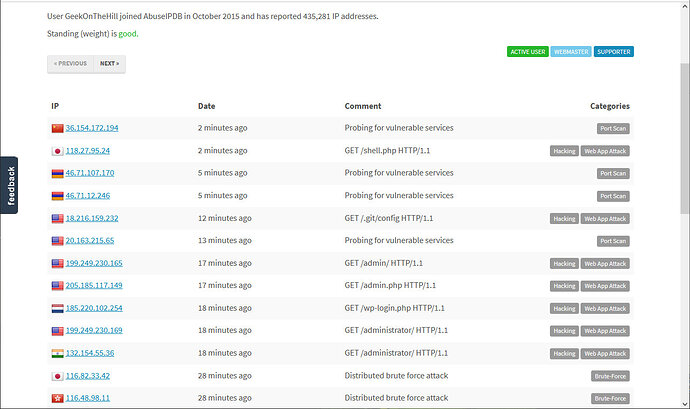Nor do I. The 404’s don’t trigger anything. The triggers are commonly-abused pages or directories that don’t exist on the site. Those would normally come up 404 on a hand-coded site, but I use .htaccess to redirect them to a trap thusly:
RewriteCond %{REQUEST_URI} /admin.php [NC,OR]
RewriteCond %{REQUEST_URI} /install.php [NC,OR]
RewriteCond %{REQUEST_URI} /lequ.php [NC,OR]
RewriteCond %{REQUEST_URI} /login.php [NC,OR]
RewriteCond %{REQUEST_URI} /setup.php [NC,OR]
RewriteCond %{REQUEST_URI} /shell.php [NC,OR]
RewriteCond %{REQUEST_URI} /user.php [NC,OR]
RewriteCond %{REQUEST_URI} /webconfig.txt.php [NC,OR]
RewriteCond %{REQUEST_URI} /wlwmanifest.xml [NC,OR]
RewriteCond %{REQUEST_URI} /wp-config.php [NC,OR]
RewriteCond %{REQUEST_URI} /wp-contacts.php [NC,OR]
RewriteCond %{REQUEST_URI} /wp-login.php [NC,OR]
RewriteCond %{REQUEST_URI} /xmlrpc [NC,OR]
RewriteCond %{REQUEST_URI} /xmlrpc.php [NC,OR]
RewriteCond %{REQUEST_URI} ^/admin/(.*)$ [NC,OR]
RewriteCond %{REQUEST_URI} ^/administrator/(.*)$ [NC,OR]
RewriteCond %{REQUEST_URI} ^/config/(.*)$ [NC,OR]
RewriteCond %{REQUEST_URI} ^/blog/(.*)$ [NC,OR]
RewriteCond %{REQUEST_URI} ^/cms/(.*)$ [NC,OR]
RewriteCond %{REQUEST_URI} ^/data/(.*)$ [NC,OR]
RewriteCond %{REQUEST_URI} ^/demo/(.*)$ [NC,OR]
RewriteCond %{REQUEST_URI} ^/fckeditor/(.*)$ [NC,OR]
RewriteCond %{REQUEST_URI} ^/.git/(.*)$ [NC,OR]
RewriteCond %{REQUEST_URI} ^/inc/(.*)$ [NC,OR]
RewriteCond %{REQUEST_URI} ^/install/(.*)$ [NC,OR]
RewriteCond %{REQUEST_URI} ^/magento/(.*)$ [NC,OR]
RewriteCond %{REQUEST_URI} ^/manager/(.*)$ [NC,OR]
RewriteCond %{REQUEST_URI} ^/media/(.*)$ [NC,OR]
RewriteCond %{REQUEST_URI} ^/news/(.*)$ [NC,OR]
RewriteCond %{REQUEST_URI} ^/old/(.*)$ [NC,OR]
RewriteCond %{REQUEST_URI} ^/plus/(.*)$ [NC,OR]
RewriteCond %{REQUEST_URI} ^/setup/(.*)$ [NC,OR]
RewriteCond %{REQUEST_URI} ^/shop/(.*)$ [NC,OR]
RewriteCond %{REQUEST_URI} ^/site/(.*)$ [NC,OR]
RewriteCond %{REQUEST_URI} ^/sito/(.*)$ [NC,OR]
RewriteCond %{REQUEST_URI} ^/staging/(.*)$ [NC,OR]
RewriteCond %{REQUEST_URI} ^/templates/(.*)$ [NC,OR]
RewriteCond %{REQUEST_URI} ^/test/(.*)$ [NC,OR]
RewriteCond %{REQUEST_URI} ^/web/(.*)$ [NC,OR]
RewriteCond %{REQUEST_URI} ^/website/(.*)$ [NC,OR]
RewriteCond %{REQUEST_URI} ^/wordpress/(.*)$ [NC,OR]
RewriteCond %{REQUEST_URI} ^/wp/(.*)$ [NC,OR]
RewriteCond %{REQUEST_URI} ^/wp1/(.*)$ [NC,OR]
RewriteCond %{REQUEST_URI} ^/wp2/(.*)$ [NC,OR]
RewriteCond %{REQUEST_URI} ^/wp-admin/(.*)$ [NC,OR]
RewriteCond %{REQUEST_URI} ^/wp-contacts/(.*)$ [NC,OR]
RewriteCond %{REQUEST_URI} ^/wp-includes/(.*)$ [NC]
RewriteRule .* /[trap-page].php?req=%{THE_REQUEST} [PT,L]
Obviously directories or pages that actually exist on a site wouldn’t be redirected. The idea is to trap people or bots that try to access common-abused pages or resources that they have no business accessing, and that don’t exist on the site.
Where the 404’s come in is that if I notice a bunch of 404’s for a particular page or resource in the stats, I research it. Usually it has to do with an unpatched vulnerability in some CMS or another; so I add it to .htaccess to trap more miscreants. The 404’s themselves don’t trigger anything except my scrutiny. 
Richard
